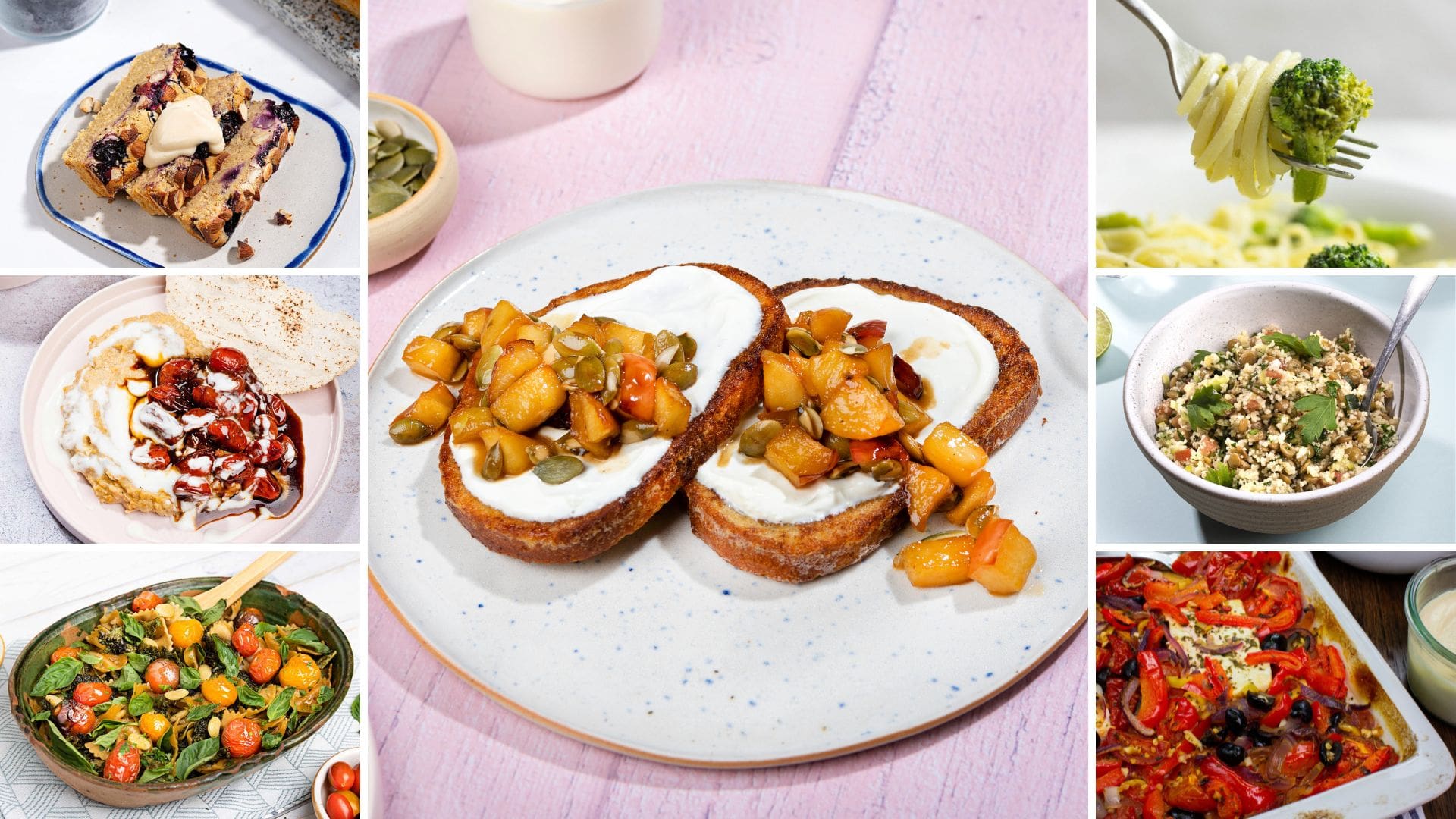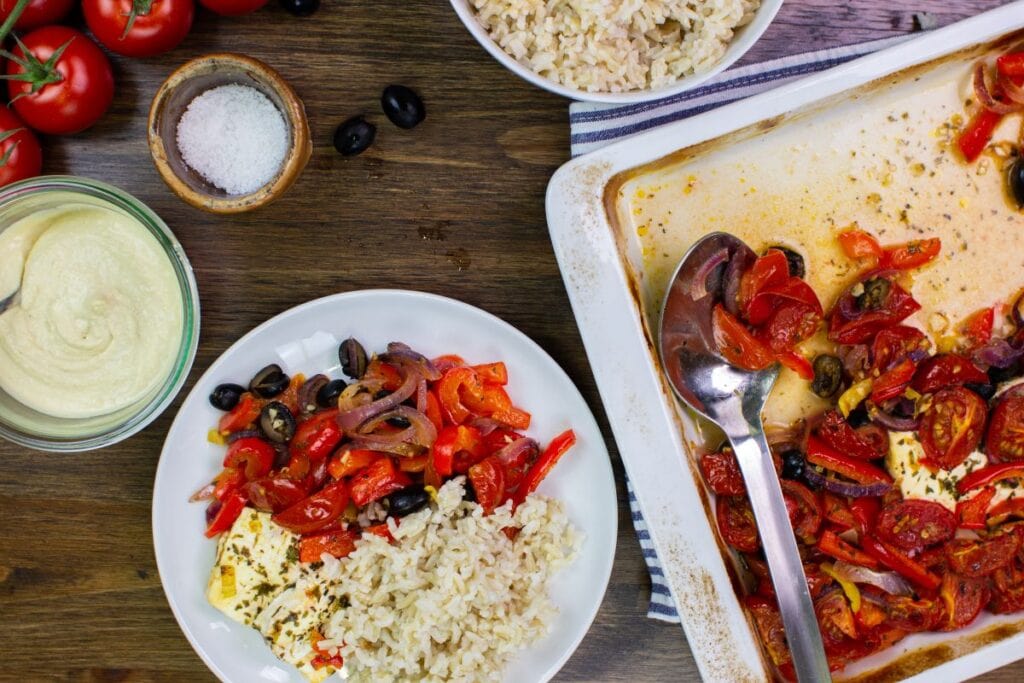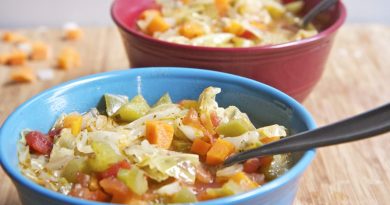7-Day Vegetarian Meal Plan for Beginners – Free to Download!
HurryTheFoodUp is reader-powered. If you click through using links on our site we may earn a small commission at no cost to you.
So, you’d like help going vegetarian for the first time? Or perhaps you’ve tried before and didn’t have as much success as you’d like.
Then good news! This vegetarian meal plan for beginners is exactly the right fit for you!

How to download and use the free 7 day vegetarian meal plan for beginners
To get going right away you can access the free 7-Day Meal Plan by using the form below. But we’d strongly advise you to read on so you can begin your vegetarian journey on the right foot!
We personally test and create ONLY vegetarian and vegan meal plans on this site. This healthy vegetarian meal plan is aimed at beginners and first-timers in particular.
We designed this meal to make the transition easy. It’s no good trying to go veggie if all you do is pine over missing meat or always feeling hungry. No, that just won’t do at all.
We also cover the topics on what a vegetarian should eat in general to cover all the nutrition bases and how to transition into the vegetarian diet, if you don’t plan to jump in cold turkey.
What the vegetarian beginner meal plan looks like
We’ve been making vegetarian recipes since 2014, and we’ve constantly been refining and streamlining them.
Access to the vegetarian diet needs to be easy for beginners, otherwise it’s no fun at all.
Day 1 of the meal plan

Here’s the first day of the vegetarian beginner meal plan. We kick things off with:
Main Meals:
Breakfast: Healthy Protein Baked Oats 409 kcal, 19g protein)
Lunch: Arugula Lentil Salad From Heaven (587 kcal, 27g protein)
Dinner: Melted Feta Veggie Bake (578 kcal, 28g protein)
Snacks:
Apple (94 kcal, 0g protein)
Smashed Cucumber with Edamame (146 kcal, 11g protein)
Daily Total:
Main Meals: 1607 kcal, 73g protein
Snacks: 240 kcal, 11g protein
= 1847 kcal, 84g protein
I know this is a beginner’s meal plan and you might have no intention to lose weight, gain muscle or whatever.
So, if you just want to enjoy veggie meals, ignore those numbers. Be assured the main intention of those meals here are taste, speed and variety.
But, if you are curious about calories and protein, here you go 🙂
Females and Males
Current advice suggests active females and sedentary males need about 2,000 calories per day. This is exactly what the meal plan provides.
Active males and highly active females may need around 2,500 calories per day, or more depending on their activity levels.
We recommend that men who follow current government guidelines on daily activity include the ‘optional snack’. As we can’t cater for every individual case please contact us if you are unsure whether this meal plan is suitable for you and we will be happy to help.
A few notes on how we structured the meal plan:
Simple: Our recipes need to be quick, easy to follow, no fancy ingredients and tasty. If you don’t look forward to the meals, then you won’t stick to them. We keep breakfast quick, and we like to pick lunches that pack well. That means you can take them with you to work, or if you’re on the go.
Variety: Our meal plans show you what the vegetarian diet has to offer without overwhelming you. This also means we kept an eye on how much bread, legumes, eggs, dairy and starchy vegetables you’ll get per day to not make things repetitive.
Protein: Each meal contains a good amount of protein, because we know this is not always easy to achieve, especially as a beginner vegetarian. At the same time this is very important for many people (not without reason).
Perishable first: If you only do one grocery haul per week, no problemo! We made sure recipes with easily perishable ingredients (leafy greens) are placed in the beginning of the week, while the recipes with sturdier ingredients (zucchini, carrots) are set to the end of the week.
Make-ahead: We also LOVE make-ahead recipes and recipes that you can make a larger batch of. That means some meals just need to be reheated, or you can freeze them for easy access when you’re in a hurry or have had a long day.
How to start on a vegetarian diet?
There are two ways of going vegetarian for beginners.
The first way: Go cold turkey and try the entire meal plan. That’s what we created the free 7-Day Meal Plan for.
The second way: Ease into the vegetarian lifestyle:
1. Try one or two new recipes a week. See if the recipes from the meal plan suit you for this. There is no pressure in making all the meals in one week. In fact the shopping list automatically updates, if you deselect recipes from the plan. Alternatively, we have hundreds more recipes on our website.
2. Substitute meat with vegetarian replacements. This way you can keep making some of your staple recipes, For example nowadays you can find some really good veggie mince suitable for pasta sauces or chilis.
3. Exclude meat, poultry and fish one step at a time. You might find it hard to give up bacon (it’s a biggi for everyone). Stick with bacon until you have a couple of veggie recipes under your belt that are equally satisfying.
We also have a comprehensive guide on taking your first veggie steps.
What should a vegetarian eat in a day?
A balanced diet full of healthy carbs, lots of protein, fiber and the right amount of fats is a great place to start. Let’s have a quick look at the macros.
Carbs
Carbohydrates are great for us in the right amounts. ‘Starchy’ carbohydrates give us calories and can also be full of vitamins and minerals.
Great examples of what we want are:
- wholegrain rice
- pasta
- oats
- wholemeal bread
- quinoa
- sweet potatoes
- potatoes
Protein
Ideally we want to make sure we spread our protein intake out evenly throughout the day rather than for example just eating a small breakfast, a small lunch and then a big dinner with a protein source (the “classic” slice of toast for breakfast, small salad for lunch, big evening meal).
Good protein sources are:
- eggs
- dairy
- pulses
- tofu
- quinoa
Make your picks and try to get any of them with each meal.
Fat
Fat is very important for us! One reason is we need fat to help absorb Vitamins A, D, E and K. Without fat we can’t absorb them. In general aim for more unsaturated fat than saturated fats
Great sources of unsaturated fats are:
- olive oil
- avocado oil
- almonds
- hazelnuts
- peanuts
Sources of saturated fats in the vegetarian diet are dairy products like cheese and yogurt.
Vegetables
Bottom Line: Make sure you eat fruits and vegetables every day. Make sure to have a protein source in each meal (dairy, tofu, egg, pulses etc.). Include starchy vegetables and oils. They belong to a healthy vegetarian diet too, and will help you meet all your nutritional needs.
We also always recommend whole grains over refined white grains (think bread, pasta etc) whenever possible as the protein and nutrient content is far better).
Get Our Vegetarian Meal Plan Pack for Beginners!
With the Vegetarian Meal Plan Pack you can tackle the upcoming weeks with complete confidence.
You may already be convinced it’s a good idea to go vegetarian. Maybe it’s the health benefits. Maybe it’s the thought of using fewer animal products. Or maybe it’s hitting your nutrition goals.
Whatever the reason, you’re committed to going veggie and all the awesome things it brings with it.
But you know you’ll need a few more meal ideas, and some tips and tricks to keep you from slipping.
That’s where our Vegetarian Meal Plan Pack for Beginners comes in. Four weeks of meal plans.
It’s everything you need for going vegetarian for a month – fun, healthy veggie meals, all laid out for you.
Complete with shopping lists for the grocery store and only the best quick and healthy recipes suitable after a long and busy day.
You can edit the meal plans using our powerful online meal planner system. That means if there’s a recipe you don’t like or just don’t fancy, you can drag and drop another in its place.
The grocery list will update automatically of course, and you can either print it out or take it with you on your smartphone.
100% money back guarantee, no strings attached
Frequently Asked Questions
What can I eat as a beginner vegetarian?
A well-balanced, healthy diet that keeps you feeling full and satisfied is the best place to start. This includes a massive range of meals from broccoli and cheese casserole to garlic mushrooms with pasta, and breakfast burritos to mouthwatering lentil tacos. There’s so much to choose from!
Is a vegetarian diet healthy?
If you are eating a variety of different foods in appropriate amounts, it’s unlikely that you’ll be lacking any key nutrients as a vegetarian.
However, it can make sense to keep an eye on a few nutrients that are mostly available in animal products.
- Protein: Make sure to replace meat, poultry and fish with enough vegetarian protein (think legumes, tofu, seitan, dairy, eggs).
- Vitamin B12: For vegetarians this nutrient is available in dairy products and eggs and should be eaten daily. As a vegan it is advisable to use a supplement.
- Iron: Vegetarians need to make sure to consume legumes, whole grain, leafy grains, nuts, seeds and apricots regularly in order to replace the “potentially lost iron” from meat.
- Omega 3: This nutrient is mostly available in fish. Vegetarians have the option get omega 3 via flax seeds, chia seeds and various oils.
Are these beginner veggie meal plans really healthy?
Yes. Our veggie meal plans are carefully constructed to make sure you get all essential nutrients. We take great care to ensure plenty of protein, while also getting fatty acids, healthy fats, essential amino acids and important vitamins.
Animal proteins (through animal products like eggs and dairy) are included, as are plenty of plant-based proteins. We stay on top of current research and our meal plans reflect this.
We also keep the saturated fat down to guideline levels, and we generally stay away from meat substitutes as they are often very heavily processed.
How do I start going vegetarian?
Having a solid meal plan is a great way to start. That way you won’t feel like you’re missing out on anything, and you won’t feel lost when it comes to mealtime.
New recipes can also seem complicated, so using well-tested recipes with guaranteed great results will make the transition far easier.
Are these meal plans vegetarian or vegan?
These plans are vegetarian. Although we do use many plant-based foods and our plans contain plant-based recipes, we also use animal-based products like eggs and dairy.
Is this the Meal Plan Pack a 30 day vegetarian meal plan?
Technically, we use 28 days in our meal plan pack, split into 4 weeks. If you need an exact 30 day vegetarian meal plan, you can of course use the 28 days provided in the Meal Plan Pack and add 2 days from the free meal plan.
Before you go, give this meal plan recipe a test!
If you want to give one of our recipes from this vegetarian beginner meal plan a try, then I recommend the Melted Feta Veggie Bake. Wonderfully tasty, easy and filling. Enjoy!

- ½ cup brown rice (uncooked) (this is optional, and our favourite side)
- 5 oz low fat feta cheese (use regular if you prefer)
- 1 tbsp olive oil
- 2 tbsp basil, dried (fresh is fine)
- 2 tbsp parsley, dried (fresh is fine)
- 1 clove garlic
- 1 onion (red or white)
- 1 red bell pepper (your fave colour)
- 2 good handful cherry tomatoes
- 1 chili / jalapeño
- 1 handful olives
- 10 tbsp water
- Salt to taste
Optional
- 4 tbsp hummus
- 1 handful mushrooms (sliced)
- Preheat the oven to 180°C (360°F).
- Cook the brown rice according to package instructions.
½ cup brown rice
- Cut the cheese into two equal, thin pieces and lay in baking tray.
5 oz low fat feta cheese
- Layer half the dried herbs over the cheese.
2 tbsp basil, dried, 2 tbsp parsley, dried
- Chop all veg (and garlic) into small pieces and chuck in a bowl.
1 clove garlic, 1 onion, 1 red bell pepper, 2 good handful cherry tomatoes, 1 chili / jalapeño, 1 handful olives, 1 handful mushrooms
- Add the oil, salt, water and the other half of the herbs and mix well. (If using fresh herbs all go into this mix so they won’t burn).
1 tbsp olive oil, 10 tbsp water, Salt to taste
- Place the veg mixture on and all around the cheese.
- Bake for 30 mins or until veg becomes soft.
- Serve with brown rice and hummus.
4 tbsp hummus
- Done!
SERVE WITH: Brown rice and hummus are excellent companions to make that dish complete!
NUTRI INFO: 1 serving includes brown rice and hummus. If you use full fat feta cheese you’ll clock in at around 550 kcal.
Nutrition Facts
7-Day Vegetarian Meal Plan for Beginners – Free to Download!
Amount per Serving
% Daily Value*
* Percent Daily Values are based on a 2000 calorie diet.
Disclosure
We would like to take a moment to note that this post is for information purposes only. It does not claim to provide medical advice or to be able to treat any medical condition. If you have any concerns regarding your health please contact your medical practitioner before making changes.




